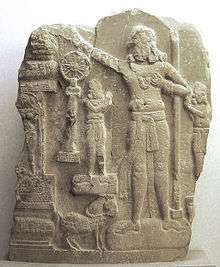Ashoka Chakra


The Ashoka Chakra is a depiction of the dharmachakra; represented with 24 spokes. It is so called because it appears on a number of edicts of Ashoka, most prominent among which is the Lion Capital of Ashoka. The most visible use of the Ashoka Chakra today is at the centre of the Flag of India (adopted on 22 July 1947), where it is rendered in a navy-blue colour on a white background, replacing the symbol of charkha (spinning wheel) of the pre-independence versions of the flag.
Symbolic history
When Gautama Buddha achieved nirvana at Bodh Gaya, he came to Sarnath on the outskirts of Varanasi. There he found his five disciples Assaji, Mahānāma, Kondañña, Bhaddiya and Vappa, who had earlier abandoned him. He introduced his first teachings to them, thereby establishing the dharmachakra. This is the motif taken up by Ashoka and portrayed on top of his pillars.
However, the 12 out of 24 spokes represent the twelve causal links taught by the Buddha and pratītyasamutpāda (conditional arising). The first 12 spokes represent 12 stages of suffering. Next 12 spokes represent no cause no effect. So, due to awareness of mind formation of mental conditioning stops. This process stops the process of birth and death i.e. nibbana. The twelve causal links, paired with their corresponding symbols, are:
- Avidyā lack of awareness -
- Sanskāra conditioning of mind unknowingly
- Vijñāna consciousness
- Nāmarūpa name and form (constituent elements of mental and physical existence)
- Ṣaḍāyatana six senses (eye, ear, nose, tongue, body, and mind) -
- Sparśa contact -
- Vedanā sensation -
- Tṛṣṇā thirst -
- Upādāna grasping[1] -
- Bhava coming to be -
- Jāti being born -
- Jarāmaraṇa old age[2] and death[3] - corpse being carried.
These 12 in reverse represent a total 24 spokes representing the dharma.
See also
Notes
- ↑ See, for example, Rhys Davids & Stede (1921-25), p. 149; and, Gombrich (2005).
- ↑ See Rhys Davids & Stede (1921-25), p. 279, entry for "Jarā," retrieved 19 Nov 2008 from "U. Chicago" at http://dsal.uchicago.edu/cgi-bin/philologic/getobject.pl?c.1:1:1721.pali[] . More than simply "old age," the PED provides the additional meanings of "decay, decrepitude"; and, these additional translations are reflected in the Buddha's reputed words in the Jarā Sutta (below). However, for the sake of semantic conciseness, the compound term jarā-maraṇa is here represented as "old age and death."
- ↑ See Rhys Davids & Stede (1921-25), p. 524, entry for "Maraṇa," retrieved 19 Nov 2008 from "U. Chicago" at http://dsal.uchicago.edu/cgi-bin/philologic/getobject.pl?c.2:1:3896.pali[] . The PED further contextualizes maraṇa with "death, as ending this (visible) existence, physical death...." That is, in Buddhism, maraṇa does not refer to death of the conscious process or the end of the associated suffering.